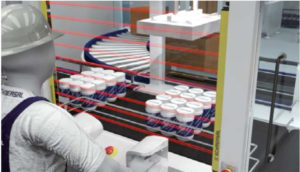by Siegfried Ruttger
![]()
The requirements are tough for the food and packaging industry: hygiene-compliant design, flexibility, short conversion times and high levels of plant availability are increasingly important features for machines and systems. In these user industries, protecting employees is still a priority, but the safety systems need to be adapted to the individual applications and contribute to the efficiency of the production processes.
In the food and packaging industries, equipment and facilities often operate with very high speed and short cycles. Safety systems from Schmersal are tailored to these requirements: they are characterised by their hygiene-compliant application and guarantee high plant availability.
One example is the RFID-based safety sensor system developed by Schmersal.As a contactless system, they are particularly suitable for hygiene-sensitive areas. Another advantage is that the sensors detect potential offset in the safety doors and can trigger a signal accordingly on an early basis. This prevents unplanned downtimes of the machine or plant. These days, machines need to be more flexible than ever before. Product life cycles are shorter and both retailers and consumers want a wider range of products and packaging. This is why modern filling and packaging machines are often modular in design, as this allows more flexible reaction to market requirements.
 Packaging manufacturers also want quick format changes so that a very wide range of package sizes can be manufactured efficiently. These requirements have implications for machine safety. Increased flexibility can be achieved by using programmable control systems which allow the safety functions to be adapted to the individual application. How this is implemented and applied by the designers of packaging machines is demonstrated by the new generation of the Schmersal safety controller known as “Protect PSC1”.
Packaging manufacturers also want quick format changes so that a very wide range of package sizes can be manufactured efficiently. These requirements have implications for machine safety. Increased flexibility can be achieved by using programmable control systems which allow the safety functions to be adapted to the individual application. How this is implemented and applied by the designers of packaging machines is demonstrated by the new generation of the Schmersal safety controller known as “Protect PSC1”.
The key components of this control system are two freely programmable compact controllers (PSC1-C-10 and PSC1-C-100). In the basic version, both have 14 safe inputs (up to PL e in accordance with ISO 13849 or SIL 3 according to IEC 61508), 4 safe semiconductor outputs, two safe relay outputs, two signalling outputs and two pulse outputs for sensors with contacts. For both variants, safe I/O expansion modules are available which can be installed either centrally in the control cabinet or on a decentralised basis. The decentralised modules communicate with the compact controller via Ethernet SDDC (Safe Device to Device Communication). There is also the option of monitoring up to 12 axes safely by means of comprehensive functions using the “Safe Drive Monitoring” module (SDM). This means the safe drive monitoring can be integrated into the compact control system with all the relevant functions.
This safety system can easily be adjusted to a wide range of different applications. In standalone machines for meat processing, e.g. on cutters and bowl cutters, the smaller variant of the central module PSC1-C-10 is used. In this case, it is fitted with the SDM option for safe axle monitoring, the memory card to save the application programmes and a fieldbus communication system for functional control. Along with the emergency stop button and a safety interlock for the bowl cover, safety sensors for safe axle monitoring on the mixing and cutting tool are also integrated into the safety circuit. On complex machines such as the combined filling and packaging systems, designers often select a decentralised control architecture.
The system can be adapted by installing the “PSC1-C-100” compact controller in the control cabinet and multiple decentralised expansion modules in the sub-distribution systems. In this case the safe remote IO communication ensures the safe exchange of signals with the decentralised expansion modules. The safety controller also communicates with the controller operating the system via the universal communication interface.
Hygiene-compliant design is an absolute must in the food industry. Further requirements included a high degree of protection and good resistance, including to detergents, as food processing systems are cleaned regularly and thoroughly.
The N-program was developed specifically for the food industry and other hygiene sensitive applications. The command and alarm devices have been tested and certified by the food and packaging testing and certification body of the DGUV for suitability with hygiene-sensitive applications.
The Fraunhofer Institute IPA has also confirmed its suitability for use in production areas in the highest clean room class (air purity class 1 in accordance with ISO 14644) and in production environments for sterile preparations up to GMP class C in accordance with the GMP guidelines. All operating devices in the program also meet the requirements of protection type IP 69 K.
Article originally published in: Getränke + Lebensmittel Herstellung 2016, Kuhn Fachverlag, from http://www.schmersal.net
